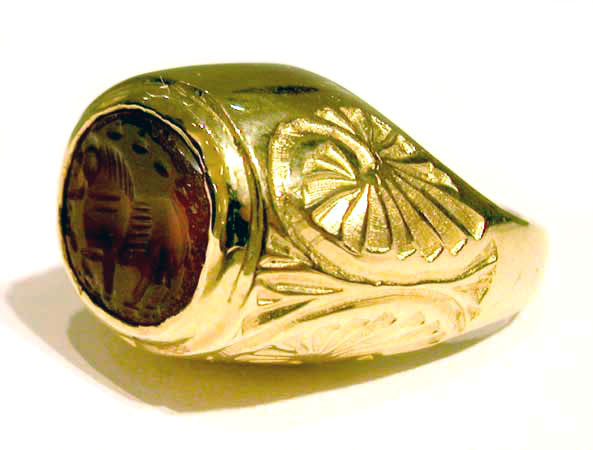Gold Ring Featuring a Sassanid Intaglio Seal Depicting a Horse, 2nd Century CE - 6th Century CE
Carnelian, Gold
FJ.6640
Further images
Glyptics, or carving on colored precious stones, is one of the oldest known art forms. Intaglios, gems with an incised design, were made as early as the fourth millennia B.C....
Glyptics, or carving on colored precious stones, is one of the oldest known art forms. Intaglios, gems with an incised design, were made as early as the fourth millennia B.C. in Mesopotamia and the Aegean Islands. They exhibit a virtuosity of execution that suggests an old and stable tradition rooted in the earliest centuries. The tools required for carving gems were simple: a wheel with a belt-drive and a set of drills. Abrasives were necessary since the minerals used were too hard for a metal edge. One difficulty of engraving intaglios, aside from their miniature proportions, was that the master had to work with a mirror image in mind.
The Sassanid Empire was a Persian dynasty ruling from 224 until 651 A.D. and last line of Persian kings before the Arab conquest. The Sassanid era was marked by wars against Romans, Armenians, and Huns and by the revival of Zoroastrianism, an ancient Persian religion founded in the 6th Century B.C. This carnelian intaglio reveals the fine craftsmanship of Sassanid glyptic artisans whose work rivals the quality of the finest Roman seals.
The deep red hue of the carnelian is perfectly complemented by the gold setting. The sides of the ring have been elegantly engraved in a stylized palmette motif, echoing the intricate carving of the seal itself. The representation of a horse demonstrates the creature’s vital importance to the Sassanid kingdom, in respects both to warfare and transportation. The beauty of this ring is timeless, a treasure that would be as valued during the Sassanid Empire as it is today.
The Sassanid Empire was a Persian dynasty ruling from 224 until 651 A.D. and last line of Persian kings before the Arab conquest. The Sassanid era was marked by wars against Romans, Armenians, and Huns and by the revival of Zoroastrianism, an ancient Persian religion founded in the 6th Century B.C. This carnelian intaglio reveals the fine craftsmanship of Sassanid glyptic artisans whose work rivals the quality of the finest Roman seals.
The deep red hue of the carnelian is perfectly complemented by the gold setting. The sides of the ring have been elegantly engraved in a stylized palmette motif, echoing the intricate carving of the seal itself. The representation of a horse demonstrates the creature’s vital importance to the Sassanid kingdom, in respects both to warfare and transportation. The beauty of this ring is timeless, a treasure that would be as valued during the Sassanid Empire as it is today.







